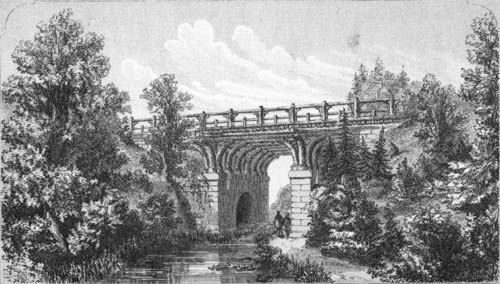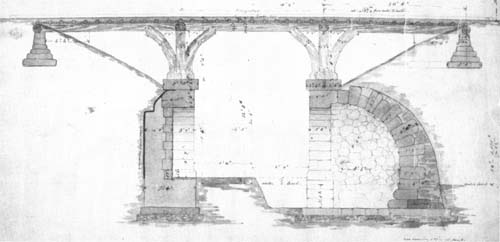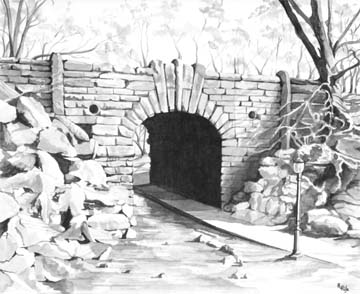Glen Span, carrying the West Drive on the latitude of 102nd Street, serves as a gateway to the wooded and secluded Loch to the northeast, surrounded by rustic bridges and what almost seems like a forest. A pathway and a babbling brook run under its archway. To the west is a view of a cascade falling from the Pool on its way toward Harlem Meer. The brook is artificial because the Pool above is fed by city water. The streambed belonged to a preexisting stream known as Montayne's Rivulet.
Like Huddlestone and Springbanks, the other major archways in the Ravine, Glen Span is below the general grade of the surrounding park. These stone structures and several small rustic wooden bridges, including one nearby, just above the cascade, enhance the wilderness setting that Olmsted and Vaux sought to create.
A visit to this deep glen is a pleasant diversion in one of the more isolated areas in the park, a birdwatcher's favorite in the spring.
The arch is built of large-sized, light-gray gneiss, roughly dressed and laid in ashlar. Boulders are piled randomly around the boulder abutments placed at the time of original construction. Ornamental detail includes a belt course at the spring line, some pentagonally shaped voussoirs and upright members on each side of the east-arch elevation.
Original drawings show a different Glen Span: rustic wooden trestles, supported by rock piers, with a wooden walk and railing. Designed by Calvert Vaux and Jacob Wrey Mould, it was begun in 1863 and completed with its wooden superstructure two years later. The wood portion was replaced around 1885 with rustic stone. The span width is 16 feet with a height of 18 feet 6 inches. The underpassage is some 50 feet alongside the brook. The sidewalls on top are 65 feet long.
Within the underpass are wide archways to either side. The one to the south by the path is shallow, the north one deep. Purely decorative, these grottos are vestigial remains of a popular device of the Picturesque style.

Lithograph, showing original wooden trestles.
Seventh Annual Report, Central Park, for 1863.

Elevation and transverse section. Original engineer's drawing, showing grottos. 1863.
Municipal Archives.
| |
| |
|
| Previous page | |
Top of page | |
Next page |





